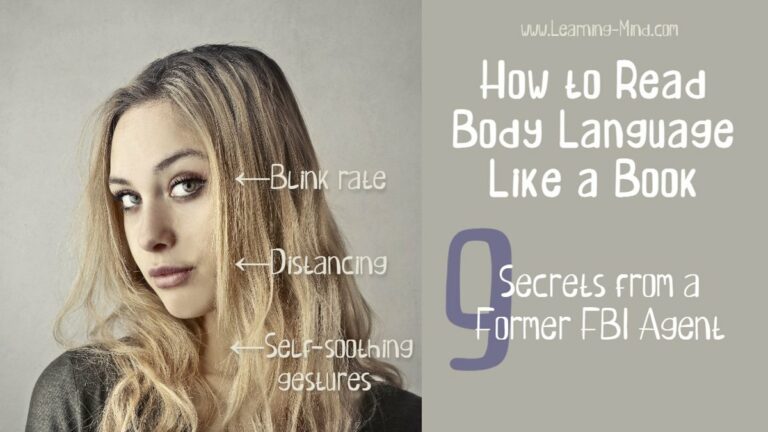How to Read Body Language Like a Book: 9 Secrets Shared by a Former FBI Agent
By Janey Davies, B.A. (Hons)
Post on February 20, 2023
Programmes such as Criminal Minds, Faking It–Tears of a Crime, and FBI Most Wanted have brought profiling body language into the mainstream. We all think we know how to read body language. But if I asked you to give me three signs that someone is lying, what would you say? Studies show that only 54% can accurately detect a lie.
So, perhaps we should look to people who are not only experts in body language, but have developed ground-breaking techniques in the science of detecting deception.
LaRae Quy worked in counterintelligence and as an undercover FBI agent for 24 years. Robert Ressler and John Douglas created criminal profiling based on body language and behavioral traits. And the UK’s Cliff Lansley examines the tiny body movements that show deception.
I’ve taken tips from LaRae Quy along with my other experts and here are their top secret tips.
How to Read Body Language: 9 Secrets from the Experts
Knowing how to read body language involves looking and listening for deviations, clues, and movements that give away our thoughts. Let’s start by looking.
1. Watch for normal behavior
How can you read body language when you don’t know the person? By looking at how they behave under normal conditions. Profilers call this ‘creating a baseline’.
For example, you have a friend that is excited to see you. One day she suddenly snaps at you in anger. She has deviated from her normal behavior/baseline. You immediately know that something is wrong. You can use this awareness when dealing with people you don’t know that well.
Building up a picture of how a person behaves when they’re not stressed is important. Once you know how someone acts when they are not under stress, it’s easier to spot when they are stressed.
2. What is the person doing differently?

Meeting someone for the first time, and talking about general topics like the weather, should not be stressful. As you chat, watch how they act. Are they talkative? Do they use a lot of hand gestures? Do they make good eye contact? Are they naturally fidgety or restrained in their movements?
Watch for changes when you move to a difficult topic. Have normally loud people suddenly gone quiet? If they usually look you in the eye, has their gaze deviated? Does the typically gesticulating person now have their hands in their pockets?
Now look for ‘tells’.
When we are under stress, our bodies give away clues or ‘tells’ indicating deception.
3. Blink rate
People think that direct eye contact is a good sign of telling the truth. However, it’s not so much eye contact but the blink rate that is important.
Body Language expert Cliff Lansley introduced us to the term ‘micro expressions’ where the body ‘leaks’ tiny gestures that belie our deception. People blink around 15–20 times a minute.
Blinking is an unconscious action. Some people think liars look away when they’re not telling the truth. Liars tend to stare whilst they are lying to convince you they are telling the truth.
However, watch for their blink rate. Studies show rapid blinking before or after talking is a sign of stress. No blinking, while they are staring at you, is also a sign of deception.
4. Mismatched synchronicity
If you want to know an easy way of reading body language, then just watch when people say yes or no. When we say yes, we nod our heads. Likewise, when we say no, we shake our heads. If the spoken yes or no matches our head movements, it is a reliable indicator we are telling the truth.
However, if the words and actions are not simultaneous, there is no synchronicity with what we are saying. It is a sign we have no confidence in what we are saying. Similarly, if we say yes and shake our heads or vice versa, this indicates lying.
5. Self-soothing gestures

Gestures such as stroking your legs, arms, hands or hair are called ‘self-soothing’ and can be a sign of deception.
You often see suspects in police interrogations rubbing or massaging parts of their bodies. They may even hug themselves by wrapping their arms around their body. Self-soothing gestures are exactly that; the person is comforting themselves because of an increase in stress.
Now let’s turn our attention to listening. Learning how to read body language isn’t just about watching people’s movements. It is also about the words and structure of what they say.
6. Qualifying language
Qualifiers are words that intensify or diminish another word. Criminals often use qualifiers to try to convince us of their innocence. Words such as honestly, absolutely, never, and literally bolster what we are saying.
If we are telling the truth, we don’t need these additional words. We use qualifying words and phrases as a convincing tactic to get others to believe us.
For instance:
“I swear to God.” “I honestly would not do that.” “I absolutely was not there.” “On my children’s life.”
There are also diminishing qualifiers such as:
“To the best of my knowledge.” “If I recall correctly.” “As far as I know.” “Honestly? I’m not sure.”
7. The linear narrative
Detectives use a brilliant question when starting off interviews with potential suspects:
“Tell me in as much detail as possible what you did yesterday, starting from when you got up.”
If you don’t know what you’re supposed to be looking for, this can seem like an odd tactic. However, detectives and FBI agents know something we don’t. But first, let’s look at an example.
You have two suspects; each one must account for their whereabouts the day before. One is telling the truth, and the other is lying. Which one is lying?
Suspect 1
“I got up at 7 am, went and had a shower. Then I made a cup of tea, fed the dog, and ate breakfast. After that, I got dressed, got my shoes and coat on, picked up my car keys, and got into my car. I stopped at a convenience store; it was around 8.15, to buy something for lunch. I arrived at work at 8.30 am.”
Suspect 2
“The alarm woke me up, and I got up, had a shower and got ready for work. I left at the usual time. Oh, hang on, I fed the dog before I left. I got to work a bit late. Yeah, I hadn’t made any lunch, so I stopped at a convenience store to get some food on the way there.”
So, have you guessed who is lying? Suspect 1 gives precise details in a linear timescale. Suspect 2 seems to be vague in their descriptions and their timeline goes backwards and forwards.
So, who is telling the truth?
The reason experts ask for a story-line of events is that when we lie, we tend to give our description of events in a linear narrative. In other words, we describe the start to finish, typically with exact times, and do not deviate from this start-to-end story-line.
As it is harder to remember a lie, we must cement that lie within an immovable structure. That structure is the defined linear start-to-finish story.
When we tell the truth, we jump all over the place, time-wise. This is because we are remembering events as we recall the memories in our minds. Some events are more memorable than others, so we recall them first. It is not natural to remember in a linear way.
So, listening to the story is important when you are learning how to read body language.
8. Nondescript descriptors
If I asked you to describe your kitchen, you’d be able to do it easily.
You might say that it is a galley-shaped kitchen with a low chef’s style sink next to a window facing the back garden. It has a minimalist look to it, as you don’t like clutter. The colors are grey and silver; the floor is linoleum, but it looks like tiles in a square, block pattern, and you have black appliances to match.
Now imagine you need to convince me you have stayed in a hotel room you’ve never seen before. How would you describe that room, if you had never been in it?
Your descriptors would be vague, without much detail. For example, you might say that it’s a typical hotel room layout. The bed was comfortable; the facilities are okay; you don’t mind the view and the parking was convenient.
See how the two descriptors are different? One is full of rich imagery, and the other is vague and could be applied to almost any hotel room.
9. Distancing tactics

It’s not natural to lie. We find it difficult, so we use tactics that make lying easier. Distancing ourselves from a victim or situation eases the stress of lying.
Remember Bill Clinton declaring:
“I did not have sexual relations with that woman.”
Clinton is distancing himself when he calls Monica Lewinsky ‘that woman’. Criminals often use this tactic in interrogations with the police. They will not use the victim’s name, substituting he, she, or them.
In another example, a BBC interviewer asked Prince Andrew about a particular event and he replied: “Didn’t happen.” Notice he did not say, “It didn’t happen.” By omitting ‘it’, he could be referring to anything.
Conclusion
I think knowing how to read body language is like having a superpower. You can evaluate people and situations by getting inside their minds without them knowing.
References:
Janey Davies
Sub-editor & staff writer at Learning Mind
Janey Davies has been published online for over 10 years. She has suffered from a panic disorder for over 30 years, which prompted her to study and receive an Honours degree in Psychology with the Open University. Janey uses the experiences of her own anxiety to offer help and advice to others dealing with mental health issues.
Compiled by http://violetflame.biz.ly from:
Reminder discernment is recommended.
The Truth Within Us, Will Set Us Free. We Are ONE.
No Need of Dogmatic Religions, Political Parties, and Dogmatic Science, linked to a Dark Cabal that Divides to Reign.
Any investigation of a Genuine TRUTH will confirm IT.
TRUTH need no protection.
Question: Why the (fanatics) Zionists are so afraid of any Holocaust investigations?
Main Site:
EN http://violetflame.biz.ly
EN http://violetflame.biz.ly



No comments:
Post a Comment